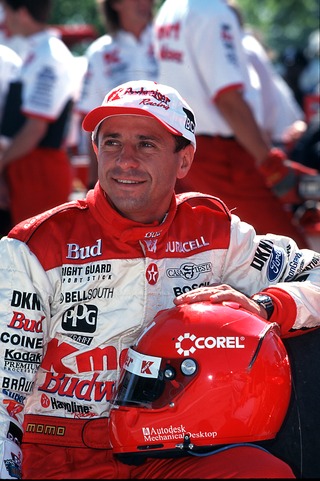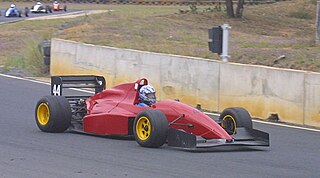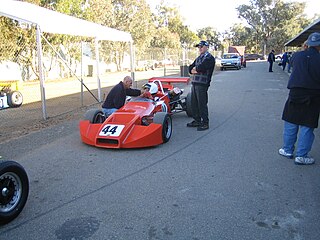
The Formula 3000 International Championship was a motor racing series created by the Fédération Internationale de l'Automobile (FIA) in 1985 to become the final preparatory step for drivers hoping to enter Formula One. Formula Two had become too expensive, and was dominated by works-run cars with factory engines; the hope was that Formula 3000 would offer quicker, cheaper, more open racing. The series began as an open specification, then tyres were standardized from 1986 onwards, followed by engines and chassis in 1996. The series ran annually until 2004, and was replaced in 2005 by the GP2 Series.

Formula Three, also called Formula 3, abbreviated as F3, is a third-tier class of open-wheel formula racing. The various championships held in Europe, Australia, South America and Asia form an important step for many prospective Formula One drivers.
Lola Cars Limited is a British automobile manufacturer founded in 1958 by Eric Broadley in Bromley, England. The company is now owned by Till Bechtolsheimer, which he purchased in 2022. Lola Cars endured for more than fifty years to become one of the oldest and largest manufacturers of racing cars in the world. Lola started by building small front-engine sports cars, and branched out into Formula Junior cars before diversifying into a wider range of sporting vehicles. In 2012, Lola Cars stopped operations. Lola is set to make a return to motorsport in 2024 by joining the Formula E World Championship as a powertrain supplier in a technical partnership with Yamaha with Abt as their customer.

Roberto Pupo Moreno, usually known as Roberto Moreno and also as Pupo Moreno, is a Brazilian former racing driver. He participated in 75 Formula One Grands Prix, achieved 1 podium, and scored a total of 15 championship points. He raced in CART in 1986, and was Formula 3000 champion before joining Formula One full-time in 1989. He returned to CART in 1996 where he enjoyed an Indian summer in 2000 and 2001, and managed to extend his career in the series until 2008. He also raced in endurance events and GT's in Brazil, but now works as a driver coach and consultant, and although this takes up a lot of his time, he is not officially retired yet, as he appears in historic events. Away from the sport, he enjoys building light aeroplanes.
Pacific Racing was a motor racing team from the United Kingdom. Following success in lower formulae, the team took part in two full seasons of Formula One, in 1994 and 1995, entering 33 Grands Prix without any success.

Formula Holden was an Australian open wheel racing category introduced in 1989.
The Barber Dodge Pro Series was a professional open-wheel auto racing series from 1986 to 2003. It was one of the first professional spec series for open-wheel racecars in North America. The races were primarily on road and street courses in North America, although the schedule did sometimes include a few ovals.

Cheetah Racing Cars was a prolific Australian manufacturer of race cars. The cars were almost solely designed, engineered and constructed by Brian Shead in a small factory at the rear of his home in Mordialloc, a suburb of Melbourne, Australia.
Van Diemen International, Ltd. was a British race car manufacturer based in Snetterton, Norfolk, United Kingdom. The company had a reputation for high-volume production runs of its cars, the most well-known of which is its series of Formula Ford chassis, which have been at the forefront of that class of motorsport for over 20 years and led it to becoming the largest manufacturer of bespoke racing cars in the world.
The 1991 Formula 3000 International Championship was the seventh season of Formula 3000 in Europe. Christian Fittipaldi won the championship after ten rounds.
The 1992 Formula 3000 International Championship was the eighth season of Formula 3000 in Europe. Luca Badoer won the ten-round championship.
Gary Anderson is a Northern Irish semi-retired racing car designer and motorsport pundit/commentator.
Russell James Spence is a British racing driver. He now runs a construction business in London. In 2011, Spence was jailed for 13 months for his part in a fraud scam involving a chain of car washes.
The Formula Chrysler Euroseries was a single-make open-wheel racing series based in Europe. It ran only in 2001.
The 2000 Australian Drivers' Championship was a CAMS sanctioned national motor racing title for drivers of cars conforming to Formula Holden regulations. The title was contested over an 8-round, 16 race series with the winner awarded the 2000 CAMS Gold Star. The championship, which was promoted as the 2000 Holden Australian Drivers' Championship, was the 44th Australian Drivers' Championship and the 12th to be contested with Formula Holden or Formula Brabham cars.

Reynard Motorsport was the world's largest racing car manufacturer in the 1980s. Initially based at Bicester and latterly at Reynard Park, Brackley, England the company built successful cars in Formula Ford 1600, Formula Ford 2000, Formula Vauxhall Lotus, Formula Three, Formula 3000 and CART.
The 1985 British Formula Three Championship was the 35th season of the British Formula Three Championship. Maurício Gugelmin took the BARC/BRDC Marlboro British Formula 3 Championship.

The March 821 was a British Formula One racing car used by the John MacDonald-owned RAM Racing in the 1982 Formula One World Championship. Regardless of its model designation, the car had no connection with long-established race car manufacturer March Engineering. The car did not score any world championship points. Designed by Adrian Reynard, a total of five cars were built. It was also the last Formula One car to bear the "March" name until 1987, with March focusing most of their attention and resources into CART IndyCar racing.
The Reynard F3000 cars are open-wheeled Formula 3000 cars, designed and developed by Malcolm Oastler, and constructed and built by British manufacturer Reynard Motorsport.
The Reynard 883 is an open-wheel Formula 3 race car, developed and built by Reynard in 1988.







